Several species of grouse inhabit my backyard (Wrangell/St. Elias National Park and Preserve), Alaska. Above, sharp-tailed grouse.
video link below: Grouse in my backyard

Several species of grouse inhabit my backyard (Wrangell/St. Elias National Park and Preserve), Alaska. Above, sharp-tailed grouse.
video link below: Grouse in my backyard
 Unlike most species of gulls, Bonapart’s gulls nest in trees.
Unlike most species of gulls, Bonapart’s gulls nest in trees.
Baby Bonapart’s gulls stayed in the nest for a day before jumping out and heading for nearby boreal ponds.

The aggressive and noisy Bonaparte’s gulls emit ear-splitting screams and drop hot, slimy poop bombs as they drive away enemies from their eggs and young, leaving enemies from ravens to eagles to nosy photographers diving for cover.
Bonaparte’s gull attacks!
To view video of Bonaparte’s gull click the link below.
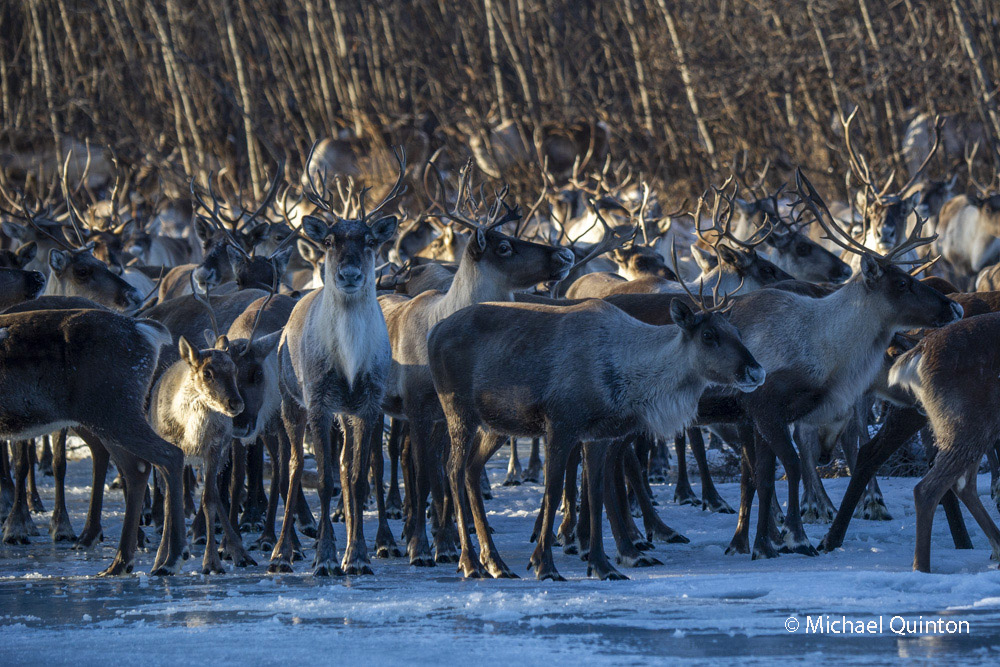 For two weeks I’d waited along this frozen river in the hopes of photographing the semi-annual caribou migration. Altogether I saw about two hundred caribou, a mere trickle compared to some years. One large group (above) had close to one hundred fifty caribou and the remaining stragglers were in pairs or small groups. The bulk had passed to the west of here earlier.
For two weeks I’d waited along this frozen river in the hopes of photographing the semi-annual caribou migration. Altogether I saw about two hundred caribou, a mere trickle compared to some years. One large group (above) had close to one hundred fifty caribou and the remaining stragglers were in pairs or small groups. The bulk had passed to the west of here earlier.
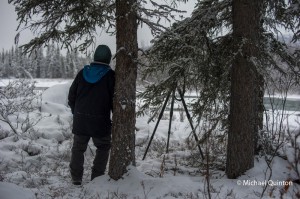 I knew from past migrations that the freezing rivers naturally funnel the caribou to this big bend in the Copper River Basin. The river, frozen on both sides, was still open in most places down the middle. I had located four likely places on the big bend where caribou had crossed, places with enough cover for a photo ambush. I moved between my ambush points to stay warm and pack down the trail between them so I could quickly move from one to another. On most days I saw no caribou. Though painfully slow, action could come at any moment.
I knew from past migrations that the freezing rivers naturally funnel the caribou to this big bend in the Copper River Basin. The river, frozen on both sides, was still open in most places down the middle. I had located four likely places on the big bend where caribou had crossed, places with enough cover for a photo ambush. I moved between my ambush points to stay warm and pack down the trail between them so I could quickly move from one to another. On most days I saw no caribou. Though painfully slow, action could come at any moment.
And when caribou are suddenly bearing down on my hide, I start forgetting things. Things like warm cabin and cold feet. And exactly, what is it I’m supposed to be doing with the camera? Luckily symptoms of buck fever are temporary.
 Of course more often than not the caribou would decide to cross where I wasn’t. With tripod and camera over my shoulder I hurried down my trail trying to stay in camera range. Out of time and breath, I planted the tripod like a mono-pod into the snow and clicked away as they plunged in and swam across.
Of course more often than not the caribou would decide to cross where I wasn’t. With tripod and camera over my shoulder I hurried down my trail trying to stay in camera range. Out of time and breath, I planted the tripod like a mono-pod into the snow and clicked away as they plunged in and swam across.
When I first noticed the caribou calf, it was in the river being carried past me by the current. He managed to climb onto an ice island in the middle of the river. After a couple of minutes he struggled to stand. Even though exhausted, the six month old calf, separated from his mom and in maximum migration mode, was pressed by the urge to keep going. Walking to the edge of the ice he stepped in with a plop and swam across the ten feet of open water but did not attempt to climb out. Instead he turned back to the island, climbed out, laid down and curled up. I stayed hidden knowing if he saw me now he might panic. The calf was in trouble and travel would wait. A rest and recharge now could only help tip the balance in his favor. Half an hour later the six month-old calf was still asleep on the ice. As I slowly moved away and headed home, I had a hunch this young caribou was a survivor.
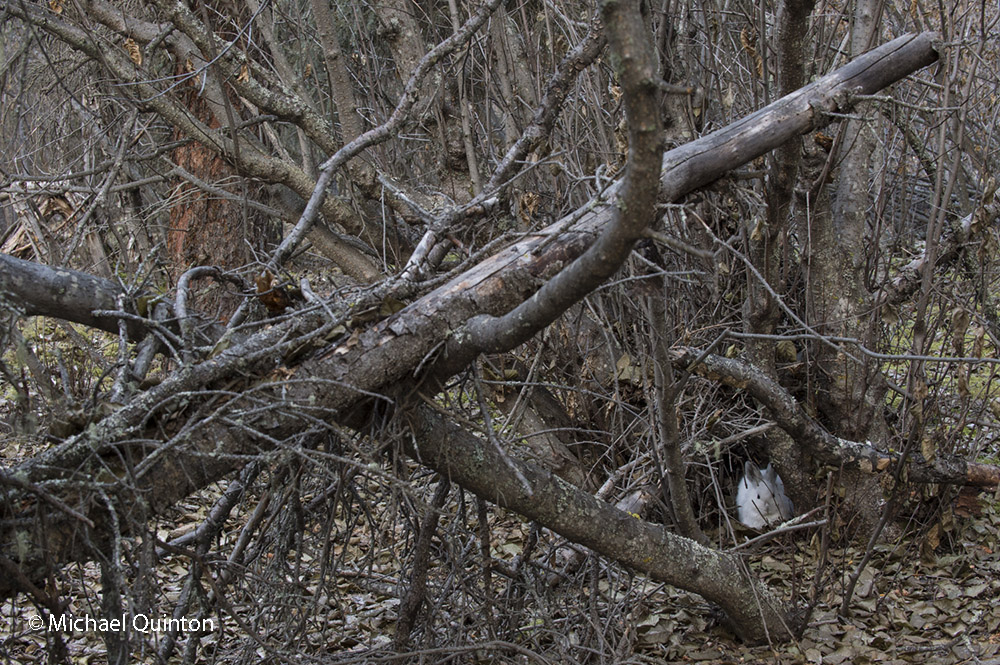 Winter seems to come later and later these past few years. And when that happens the local snowshoe hares are left feeling a bit conspicuous against their drab brown and gray habitat. The snowshoe hares count on their turn coats (brown in summer and white in winter) to help them hide from a gauntlet of predators like lynx, marten, red fox, northern goshawk, great hornedowls to name just a few.
Winter seems to come later and later these past few years. And when that happens the local snowshoe hares are left feeling a bit conspicuous against their drab brown and gray habitat. The snowshoe hares count on their turn coats (brown in summer and white in winter) to help them hide from a gauntlet of predators like lynx, marten, red fox, northern goshawk, great hornedowls to name just a few.
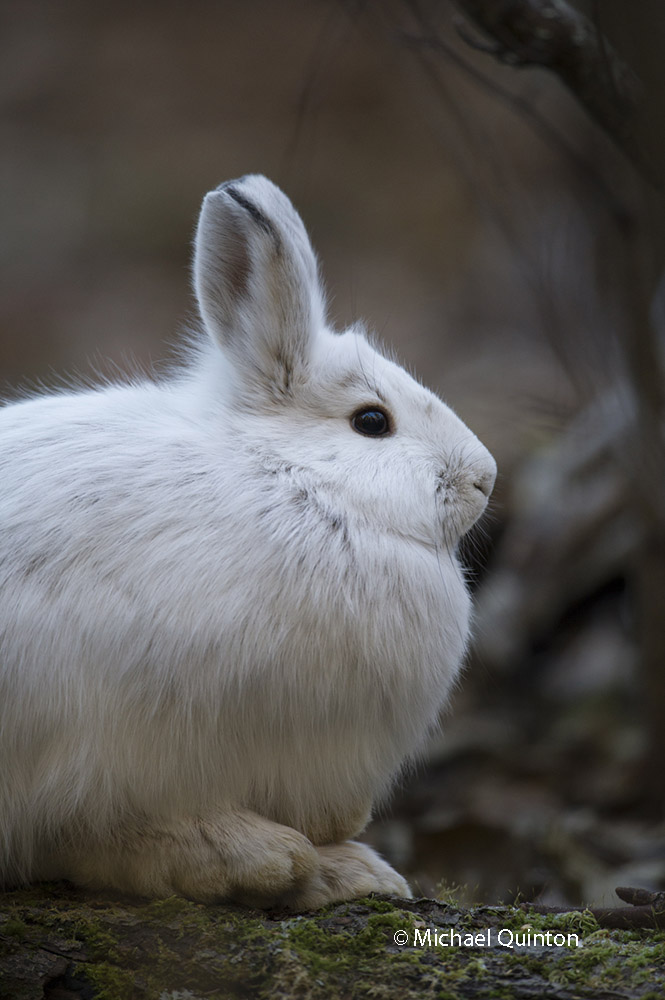 Normally shy, snowshoe hares may tire of dodging my efforts to photograph them after a few attempts and eventually allow me a few close-up shots.
Normally shy, snowshoe hares may tire of dodging my efforts to photograph them after a few attempts and eventually allow me a few close-up shots. 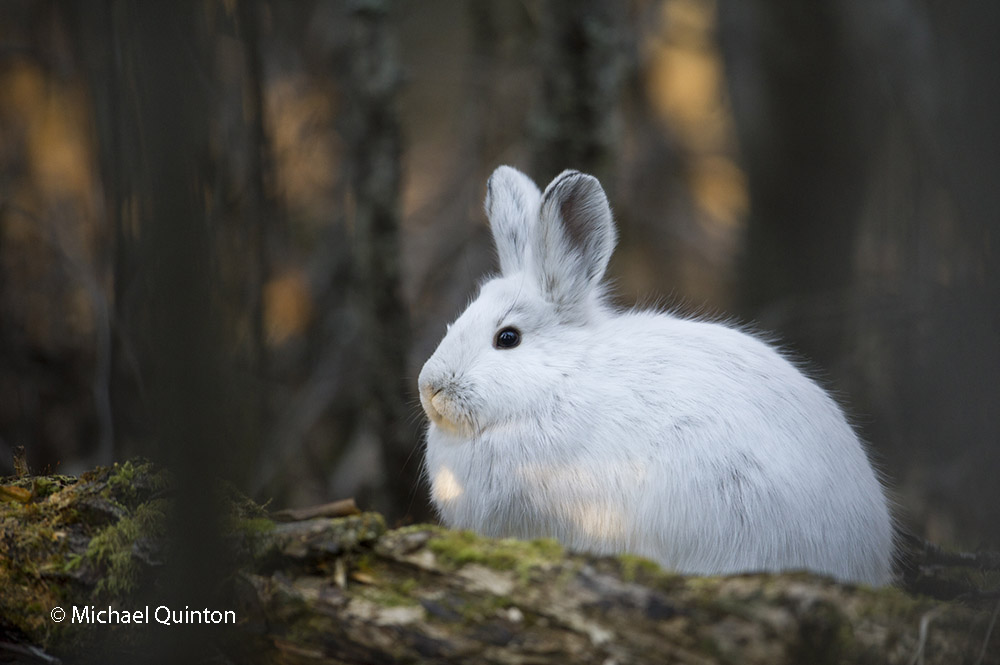 But days of white snowshoes in their snowless habitat are numbered. Snow is inevitable and soon they will be hiding in plain sight just as nature intended,
But days of white snowshoes in their snowless habitat are numbered. Snow is inevitable and soon they will be hiding in plain sight just as nature intended,
https://youtu.be/9ewR7-Rgeis
1850 still photos into a one minute video.
https://youtu.be/ZiuzOzNt80g
Each winter dall sheep migrate to their rugged, windswept slopes. It is here that their dramatic rut takes place.
https://youtu.be/V64iQtqFnzI
I braved the twenty below night temperatures, took 1,159 photos over a four hour period and linked them into a munute long video.
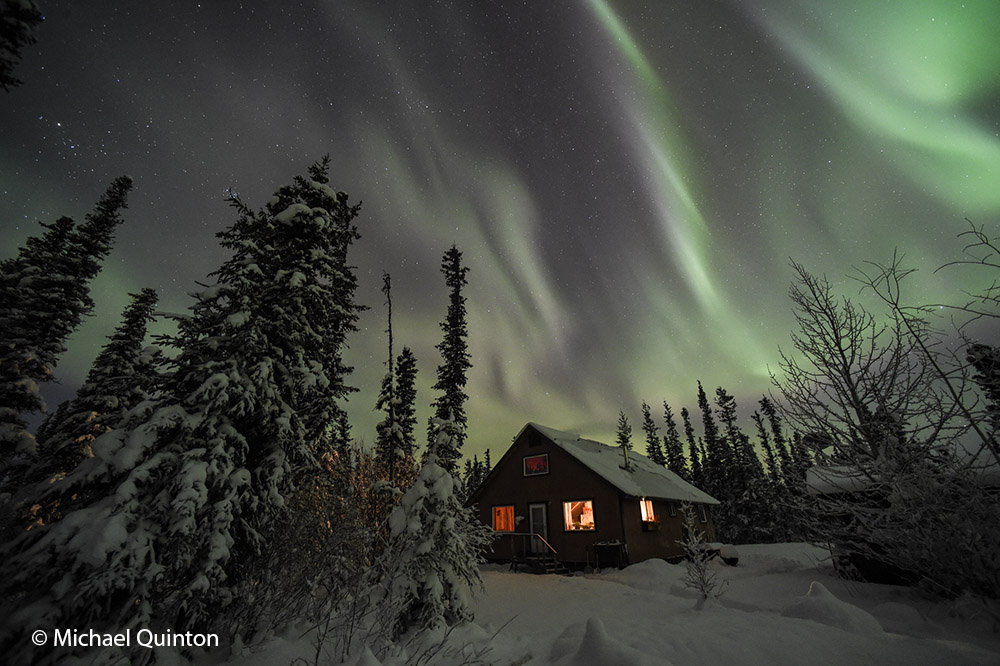 Our home in the wilderness.
Our home in the wilderness.
This post is in support of the recent story that appeared in the February 2016 issue of Country Magazine. The story is about our families life in Alaska. The following photographs are some that did not make the final layout in the magazine. Several Country Magazine readers have requested to see more photos. This is for you. Continue reading
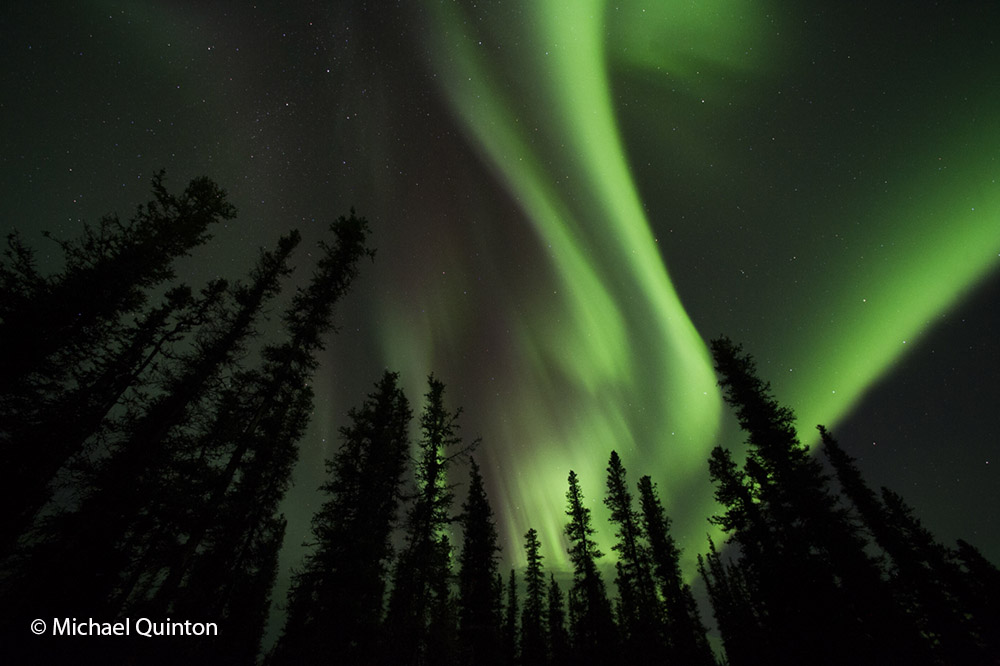 Aurora borealis in my back yard. Slana, Alaska
Aurora borealis in my back yard. Slana, Alaska
The aurora borealis displays are really picking up this year. After a few years of slow aurora activity its an exciting change and a great excuse for stay up late and snapping a few photographs. With todays wonderful digital cameras getting great aurora photos is easier than ever. I remember the day when I had only Kodachrome film with an ASA speed of either 25 or 64. Living in Alaska it could take more than two weeks just to get your processed film returned and check your results. Today you can snap a shot or two check the exposure using your histogram display, adjust your exposure if necessary and shoot away . You can be confident of what you’re getting. Continue reading
 Spectacular Wrangell Mountains in Alaska seem insignificant in this ineffective wide-angle photograph.
Spectacular Wrangell Mountains in Alaska seem insignificant in this ineffective wide-angle photograph.
I remember my own fascination with the wide-angle lens. My first was a 24mm. The wide view had great appeal to me. It was thrilling to look at the landscape thru my lens. I could fit entire mountain ranges onto my tiny Kodachrome slide! And there lies the problem. A wide-angle lens often includes too much information with detail that is too small.
We expect the camera to record what we see. But, the fact is, we humans see things quite differently than any camera. Humans see their subject subjectively. We concentrate on our subject and don’t notice much else, missing details that we should be paying close attention to.
The camera records everything within the viewfinder, it sees objectively. Right down to all those distracting details we failed to notice.
In contrast, when we look at a mountain range or desert, we see the mountains, the terrain, we feel the wind, we get dust in our eye, we feel the cold or hot, We smell the pines or the sagebrush and the delicate fragrance of wildflowers as our gaze dances from flower to flower and bounce along with a foraging bumble bee.
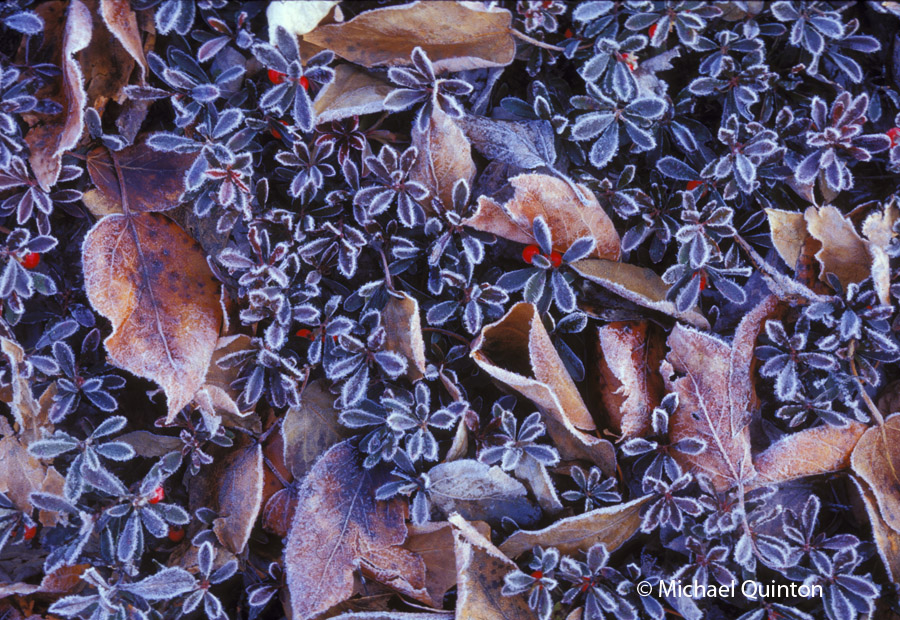 Frosty kinnickinnick and poplar leaves.
Frosty kinnickinnick and poplar leaves.
Fall colors are a favorite subject of photographers. But don’t forget to look down. That world beneath your feet is easily overlooked. Give forest understory pictures adequate depth of field by stopping down to F 16 or F 22. Focus on the most interesting details.
While my wife, Cindy and I picked high bush cranberries I noticed several beautiful, colorful and cryptic moths. Continue reading